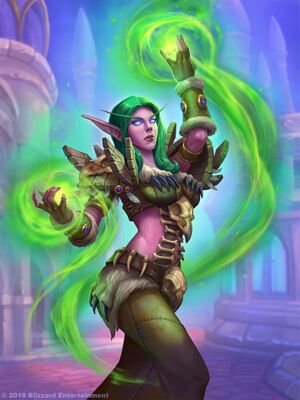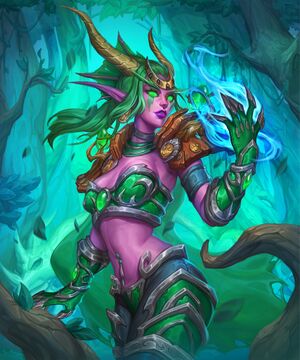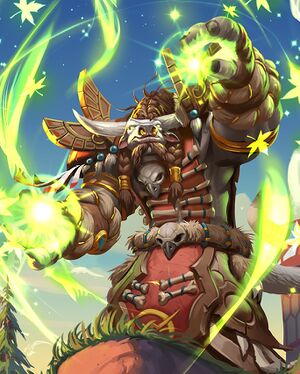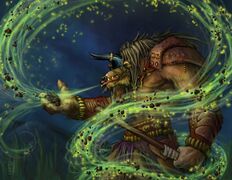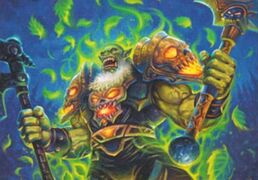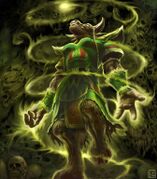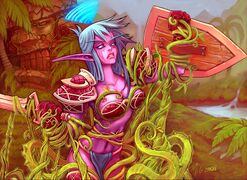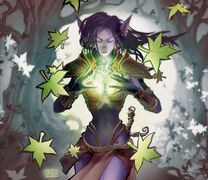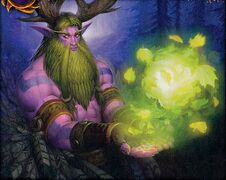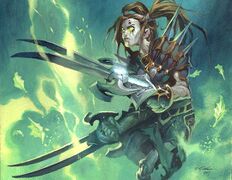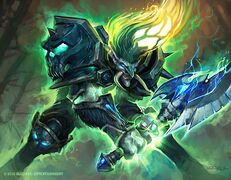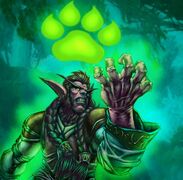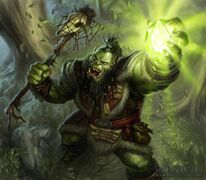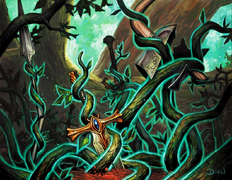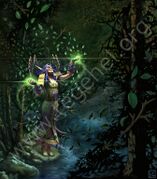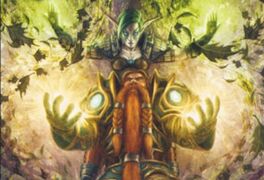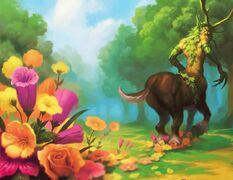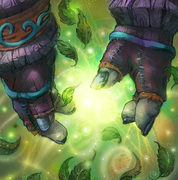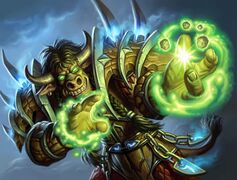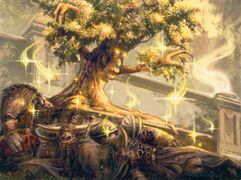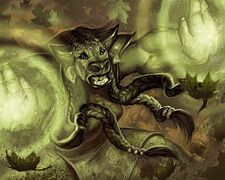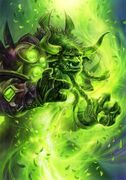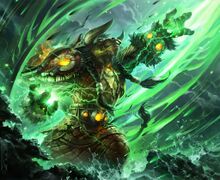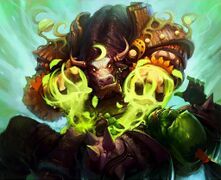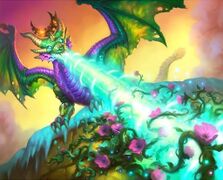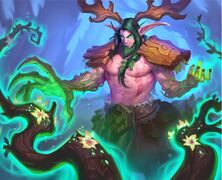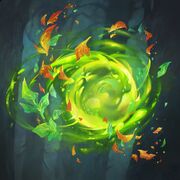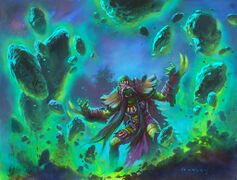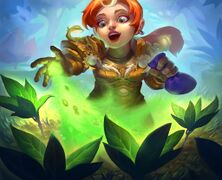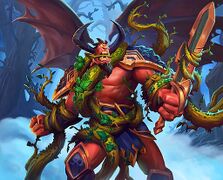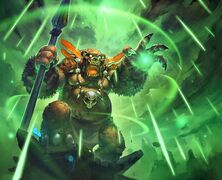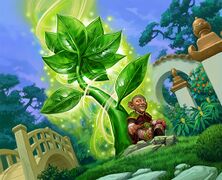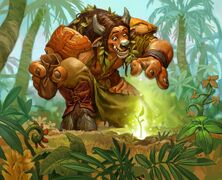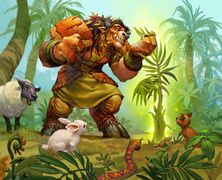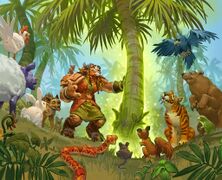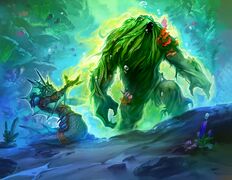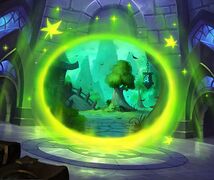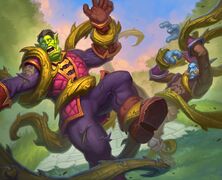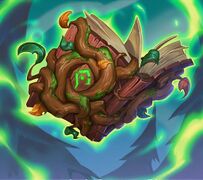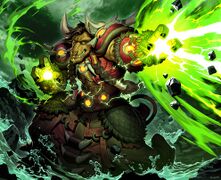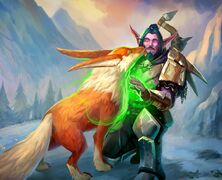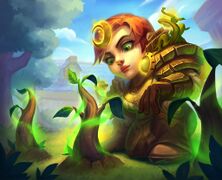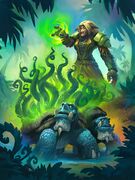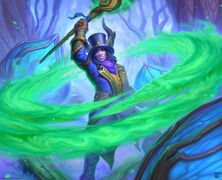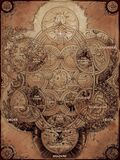Nature
“The power of nature was not found in the swing of a fist or the slice of a blade. It was found when a forest was rent to dust by fire and yet returned in only a few years. It was found when a mighty city was claimed by overgrowth after being abandoned for a decade. It was found in a thousand generations of predator and prey, which lived and hunted by the instincts of their ancestors. In the hands of a druid, that power could be condensed from centuries into a minute.”
- — Varok Saurfang's thoughts about Malfurion Stormrage[1]
Nature magic is the manifestation of Life in the Great Dark Beyond. The energies of Life promote growth and renewal in all things, and are the opposite end of the spectrum from necromantic magic, which represents Death.[2] There is a relation to the spiritual magic of shaman and the natural magic of druids.[3] The most common practitioners of nature magic are known as druids. Others include the red and green dragons; in a certain way shaman and monks; and the Wild Gods, who are primal manifestations of life and nature.[4]
Origins and characteristics
Life energy is "ancient and poorly understood."[5] Nature magic is often portrayed with bright yellows or greens, as opposed to death's pale blues and greys.
Spirit, or chi as the pandaren call it,[6] is the life force that shaman and monks manipulate.[7] Spirit energy is intrinsically linked to the elements—earth, air, fire, and water. This life-giving force interconnects and binds all things in existence as one.[2] The amount of Spirit energy available on a planet regulates the temperament of the elementals. The more spirit energy, the more docile the elementals are. A world with raging elementals such as Azeroth is indicative of a low supply of spirit energy. Beings of Life are known to flourish best in the sun's light rather than in the dark.[8]
E'ko is a term referring to a strange life force,[9] it is the spiritual power[10] that each creature of Winterspring possess. Different creatures possess different e'ko and when one of these creatures are killed a bit of their e'ko sometimes comes out. The Witch Doctor Mau'ari knows an incantation that transforms the e'ko into juju. Sur'jan used his dagger filled with the life force of dead crocolisks to restore his shaman mojo.[11] He also absorbed the life force of destroyed pterrordax eggs.[12]
When the quel'dorei linked their Runestones to Thas'alah, they managed to bind the power of Life to their arcane spells.[13] However, both magics may simply refuse to "cooperate" if there is any imbalance between them, which can prevent the intended effect or be dangerous for the spellcasters.[14][15] Conversely, fel magic is fueled by the sacrifice, often insignificant (a living fish, or a few strands of seaweed)[16] and burning of life.[17] It was considered as the greatest violation of life by the Pantheon.[18]
Solar magic
Solar magic is a form of magic practice through the use of solar energy, a radiant energy emitted by the suns. It is associated to the nature magic used by druids, rather than the holy magic used by priests and paladins.[19]
Blood magic
Blood magic is a form of tortured life magic that uses blood as a power source.[20] On Azeroth, it is shunned by many as a dark and forgotten art, as it shares in many other ways some distinct characteristics with demonic magic.[21]
Uses and powers
| This section is a lore stub. |
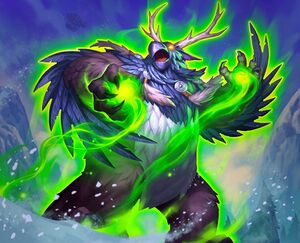
The elements that carve form into the universe are fluid forces of nature. Some beings seek to bend the power of these natural elements to their will. Druids, however, worship the protecting spirits of nature.[22] They work with the natural life forces of the world,[23] and harness the vast powers of nature to preserve balance and protect life. With experience, druids can unleash nature's raw energy against their enemies, raining celestial fury on them from a great distance, binding them with enchanted vines, or ensnaring them in unrelenting cyclones. By calling upon the powers of nature, druids are able to direct this power to heal wounds and restore life to fallen allies.
As master shapeshifters, druids are deeply in tune with the animal spirits of Azeroth, they can take on the forms of a variety of beasts, morphing into a bear, cat, storm crow, or sea lion with ease. This flexibility allows them to fill different roles during their adventures, tearing enemies to shreds one minute and surveying the battlefield from the sky the next.[24] As druid healing involves life force being drained and transferred,[25] they ask the surrounding nature to lend them their energy in order to cast spells or to aid them in battle.[26][27] They call upon the versatility of nature to empower themselves, assuming the forms of primal beasts, summoning celestial energy, and channeling the restorative properties of the wilds to aid their allies.[28]
Nature magic, along with arcane magic, are used by night elf healers to mend the body of a deceased individual for a final viewing as part of their traditions.[29]
Created by Malfurion Stormrage, under the direction of the demigod Cenarius during the War of the Ancients, the Axe of Cenarius is a two-handed magical wooden axe crafter with druidic magic. It was enchanted with a piece of Kalimdor's magic, making it light as a feather and stronger than any mortal-forged axe, and able to slice through any foe with ease.[30]
Effects on beings
Some night elves were so transformed by the teachings of Cenarius that they never left his realm, choosing to remain by Cenarius' side as his defenders. These few would cease to be elves and became woodland guardians physically altered forever.[31]
Practitioners
- See also: Druid organizations
Druids
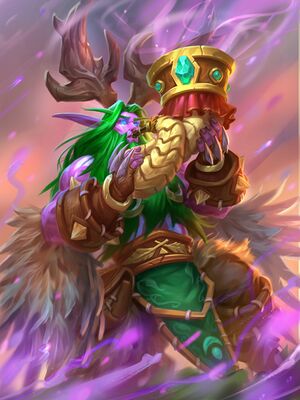
Druids are the most known practitioners of nature magic.[32] Druidism derives from nature, enabling them to channel natural energies and transform into animals. They live in a state of unparalleled union with nature, and are shape-shifters with an affinity for the plants and animal kingdoms. Tightly bound to the plant and animal kingdoms, they are natural shapeshifters, and so they know firsthand the abuse visited on their wild brethren. In consequence, despite their numbers, druids tend to be wary, reclusive, and difficult to spot. Few outsiders have plumbed the depths of their secrets.[33] They maintain a deep connection to nature through the Emerald Dream, a primordial realm that encompasses all aspects of nature.[34]
The many gifts provided by nature must sometimes be reciprocated. Restoration druids seek order in the world by tending directly to its many life forms. Friend to flora and fauna alike, they celebrate birth and growth. Where there is decay, they bring rejuvenation. Where there is abatement, they summon regrowth. Life not only needs protection—it needs nourishment. To foster this harmony, they build a bond with the things that grow, gaining inspiration from the flower's bloom, the seed's sprout, the mushroom's spores, and the tree's growth. Like nature, the restoration druid perseveres through patience and persistence, the foundation upon which all life is built and sustained. They use this power to mend wounds and provide persistent remedies that keep their allies from falling.[22]
Feral druids seek to curb imbalance in nature. They observe the fantastic intricacies of the physical world and the delicate fabric in which all living creatures are given purpose. Whether on land or in the sea, in a lush jungle or an uncultivated desert, death is part of the cycle which sustains life. Nature is an eternal dance between predator and prey. Like their feral brothers and sisters, they attune themselves to nature through the animal kingdom. They commune with the wild to understand how life perseveres through adversity. They know that the creatures who survive are often those built to best protect themselves and their kin. In this, they find a deep and harmonious value in the steadfast, all the while recognizing that sturdiness requires an aggressive stance when danger comes near.[22]
Monks
Masters of bare-handed combat, monks never rely solely on the need to have a weapon in their hands to defend against their enemies. Monks bring a unique martial arts style to any fight, and harness an exotic form of magical energy that's unfamiliar to those who practice other arcane arts, the Chi. They seek spiritual balance in life and in combat, and as dangerous as Monks can be on the battlefield, they're rarely looking to pick a fight without just cause. They view the world through a different lens, finding power through serenity and inner peace—then expressing it through artful combat techniques and powers that mend life.[35] Mistweavers monks are unique among those who heal. The energies they channel are mysterious, oftentimes misunderstood by commoners—who rarely travel beyond the borders of their homelands—as some form of folk medicine. But those who weave the mists wield the power of life's essence, using a mixture of preventative and restorative spells to mend their allies' wounds. The inner tranquility that guides mistweavers allows them to sustain their healing for long periods of time, and gives them the strength to care for multiple injured allies.[35]
Dragons
On Azeroth, Alexstrasza became the Dragon Aspect of Life and, together with her red dragonflight, they were made protectors of all life by the titan Eonar.[36] Since this time, red dragons have always concerned themselves with maintaining the harmony and prosperity of life They consider themselves the custodians and defenders of life on Azeroth,[37] but they will not hesitate to kill a creature if its actions endanger other lives.[38] Red dragons understand the secrets of life, and in turn, those of death, like none others do and have been granted great power over both. The breath of red dragons burns but also rejuvenates, and whenever a red dragon walks or breathes upon the soil, the earth is renewed. A red dragon would never hurt a soul, unless they tried to hurt them first.[39]
Once led by Ysera the Awakened, the green dragonflight live only to serve the forces of nature and uphold the balance between mortal creatures and the ever-evolving world.[40] Green dragons are creatures of the Emerald Dream, the ethereal dreamworld that all life is tied to. From there the green flight watches over nature, often assisted by the night elven druids. The dragons and druids work closely together within the dream where they can control the ebb and flow of nature and influence the evolutionary path it takes. Greens are, like the other flights, highly intelligent and always striving to learn more about the world they were entrusted to protect, fretting out the mysteries of creation and life - but keeping all such secrets hidden within the Emerald Dream.[41]
Night elves
The night elves are a powerful and mystical race who developed a strong empathy for the living forests of Kalimdor, and reveled in the harmonious balance of nature. The demigod Cenarius adored them and spent a lot of time teaching them about the natural world, as he believed they had the potential to become great caretakers of nature.
After the Great Sundering, the night elves founded a radically different society centered around druidism, striving to live in harmony and co-existence with nature and its inhabitants, and essentially becoming "venerable guardians" of the natural world as well as the World Tree Nordrassil, instead of ruling most of Azeroth as its foremost superpower. They also reconnected with the widespread worship of their moon goddess Elune, under the guidance of Malfurion Stormrage and Tyrande Whisperwind.[42][43]
Troll
Early troll tribes, though varying wildly in customs and traditions, all shared a common religion: the worship and reverence for the Wild Gods whom they called the loa. Through the worship and devotion of the trolls to their deities they could utilize all manner of abilities granted to them by these spirits of nature. Some, like the shadow hunters and druids could utilize the power of multiple loa at once.
Some loa are more connected to the powers of life and nature, such as Gonk, who taught all trolls how to be druids through the influence of multiple loa.[44] Torcali who is worshiped by many farmers for better harvest.[45] There are also two gods of unknown origin, the White Matron who gives her followers power over the stars and moon, and Zim'Torga who used her power to create a wall of thorns to protect the Zandalari trolls in Zul'Drak.[46]
The Zandalari troll druids are primarily composed of the Raptari, the followers of Gonk. There is also the haruspices who give their people divine guidance through communion with animals and giving them up to the spirits when needed.[47][48]
Tauren
The tauren are a noble race that embraces the natural world. Their race is one of spirituality and reverence for nature,[49] as they strive to live honorable and dignified lives filled with respect for nature and the Earth Mother.[50] They consider death to merely be the shadow of life and hold that the ending of things is as natural as the birth of them.[51]
After the Third War, Hamuul Runetotem sought Malfurion Stormrage to become his apprentice, thus becoming the first tauren druid in nearly twenty generations. While during the war against the Lich King Aponi Brightmane and Tahu Sagewind rediscovered the ancient teachings of using An'she's sun powers as a counterpart to the elven worship of Elune.
Worgen
Worgen are naturally drawn to and revere the wolf Ancient Goldrinn,[52][53] who in a way, is the progenitor of their race. Through this natural connection to nature, some took the path of druidism, while many also embrace and revere the nature-related spirits that resulted in their current status, such as Genn Greymane and his newly found reverence for Goldrinn.[54]
Shamans
Shamanism is a deeply spiritual form of elemental magic that involves a connection with both, the natural and the spirit worlds. In fact, there is a relation between the spiritual magic of shaman and the natural magic of druids, which explains why the shaman were able to hear the spirits of Stonetalon.[3] Some shaman find a serene affinity for the restorative properties of water. They do not necessarily seek the Light or turn to the divine, yet they feel a profound spiritual connection with the source from which all mortal life took root. So strong is their connection with water that the shaman is able to restore life and heal afflictions. They balance this with a command of the other elements, finding harmony in nature and purifying their allies as a tidal surge washes across a sandy shore.[55]
Others
- Botani are a race of intelligent, bark-skinned humanoids native to Draenor. 2,000 years before the opening of the Dark Portal, a treant known as Gnarlgar wandered the forests of Talador, and taught them unique ways to harness nature magic, notably to create pools of potent nature energies to transfer the spirits of fallen genesaur into new bodies.[56]
- Harpies employ nature-based magic to destroy the environments in which they settle, killing every creature they encounter and despoiling the land to build nests noted for their noxious odor.[57]
- Wildkin are serene, powerful creatures, believed by the night elves and tauren to have been created by the moon goddess Elune to protect her sacred places.[58][59] These gentle giants possess a natural energy described by an academic of the Kirin Tor to be druidic and similar to that of the night elves.[60] Among them, the moonkin are blessed by Elune and spread nature's grace wherever they travel.[61]
- The rise of organized religion such as the Holy Light, along with the arcane magic introduced by the high elves during the Troll Wars, quickly supplanted the nature-based belief systems that had been practiced by the pre-Arathorian tribes (with the exception of a surviving remnant in Gilneas).[62]
In the RPG
The nature branch of divine magic is almost entirely the province of one race. Night elves follow no faith but that of Elune, while honoring the other Ancients. Although all night elves pay tribute to Elune, those who truly hear her soft song choose the healer class and follow the path of either the druid or the priest. Most of the inhabitants of northern Kalimdor — namely the night elves, but also the furbolgs and the satyrs — worship or revere the Ancients. The night elves worship Azeroth's only deity, the eternal moon goddess Elune. They revere most of the other Ancients, especially Cenarius, the only Ancient to spend considerable time on the Physical Plane. They also honor the moon goddess's companions, including Agamaggan, Aviana, and Malorne.
Though both druidism and shamanism seem to be separated by a very fine line, the means by which they reach their ends can be classified in a fairly straightforward manner. Druids worship the spirits through plants, animals, and the fundamental spirit of the wilds. Conversely, shamans worship the spirits through the four fundamental elements of earth, fire, wind, and water.[63] Although nature spells are not a specifically defined category, a spell or effect falls into this subgroup if it clearly improves, enhances or summons creatures or objects that exist in natural, aboveground terrain.[64]
The Vanir titan Eonar is the physical representation of life, nature, and healing in the universe; she revels in the joy and bliss in all worlds.[65] Her portfolio includes nature, healing, life and, as she is a member of the Pantheon, creation and order.[66]
The furbolgs venerate the bear twins, Ursoc and Ursol; and the evil satyrs revere Lord Xavius. The Ancients rarely interfere with life on Azeroth, but these races hold fast in their fervent beliefs that the Ancients exist and are watching events unfold. Adherents from these races do not receive their power directly from the Ancients they worship; their faith allows them to tap into an inner spark, focus divine energy and cast spells.[67]
Midnight rituals of the Scarlet Crusade imbue its devotees with the ability to "infect" the undead with the spark of life — and in doing so, make them vulnerable as normal mortals. Just as the Scarlet Crusade trains its members to manipulate their life force, it also trains them to protect it. As a Crusader becomes more powerful they can use their life force to incinerate any who stand in their way.[68]
Notes and trivia
- According to the apothecaries, there is a life energy in the waters of the Barrens oases, invigorating and altering the plants and beasts that drink it.[69]
- Nature is also a school of magic in World of Warcraft. For further information, see School.
Gallery
References
- ^ A Good War, pg. 60
- ^ a b World of Warcraft: Chronicle Volume 1, pg. 13
- ^ a b
 [23] Shredding Machines
[23] Shredding Machines
- ^ World of Warcraft: Chronicle Volume 1, pg. 14
- ^
 [Glowing Seeds]
[Glowing Seeds]
- ^ Dave Kosak on Twitter
- ^ Dave Kosak on Twitter
- ^ The Sundering, chapter 10
- ^
 [15-30] Strange Life Forces
[15-30] Strange Life Forces
- ^ Witch Doctor Mau'ari
- ^
 [20-60] Crocolisk Life
[20-60] Crocolisk Life
- ^
 [20-60] Terrorizing their Eggs
[20-60] Terrorizing their Eggs
- ^ Tales of the Hunt
- ^ Crimsastrasza#Quotes
- ^ Coldostos#Quotes
- ^ The Comic Volume 4 - Whispers: "fel magic is powerful...and we are near the sea. It requires but an insignificant sacrifice--a living fish or two, a few strands of seaweed--to fuel the magic."
- ^ The Comic Volume 4 - Hard Choices: "We will use the injured gryphon's life force to power our fel magic."
- ^ Seeking the Soulstones: Blade's Edge Memory: Doomguard says: Sacrificial magic was considered the greatest violation of life.
- ^ Don Adams on Twitter: "No, they use solar magic. More comparable to the solar magic used by druids."
- ^ Muffinus on Twitter (2015-07-10). “There's nature magic, like druids use, and light magic, like priests/pallies use. Blood was tortured life. Fel is Chaos.”
- ^ Bloodmage Lynnore#Quotes
- ^ a b c Legion Class Preview Series: Druid
- ^ The Sundering, pg. 360: " Druids worked with the natural life forces of the world and who better represented that than Alexstrasza?"
- ^ https://worldofwarcraft.blizzard.com/en-us/game/classes/druid
- ^ The Demon Soul, pg. 461 - 463
- ^ The Well of Eternity, chapter 10
- ^ The Well of Eternity, chapter 20
- ^ Taking Your First Steps in World of Warcraft Classic
- ^ World of Warcraft: Grimoire of the Shadowlands and Beyond, pg. 13
- ^ The Well of Eternity, chapter 15
- ^ The Well of Eternity, chapter 4
- ^ Jeremy Feasel on Twitter (2015-07-30). “That's a tough one. Light magic comes from the Light, which is like Naaru. Life magic (e.g. what druids use) is Nature. Not a super clear distinction, but I like to think of life as growth, light as cleansing.”
- ^ World of Warcraft: Classic class description
- ^ Ultimate Visual Guide, pg. 21
- ^ a b Legion Class Preview Series: Monk
- ^ World of Warcraft: Chronicle Volume 1, pg. 46
- ^ Warcraft III: Reign of Chaos Game Manual, pg. 138
- ^ The Well of Eternity, pg. 194
- ^ Mount Journal entry for
 [Reins of the Red Drake]
[Reins of the Red Drake]
- ^ Warcraft III: Reign of Chaos manual, pg. 142
- ^
 [Legacy of the Aspects]
[Legacy of the Aspects]
- ^ Night Elf - Race
- ^ Warcraft III: Reign of Chaos Game Manual#Night Elf History
- ^ Raptari Druid#Gossip
- ^
 [Tales of de Loa: Torcali]
[Tales of de Loa: Torcali]
- ^ Exploring Azeroth: Northrend, pg. 56
- ^
 [60R] Paragons of Power: The Haruspex's Belt
[60R] Paragons of Power: The Haruspex's Belt
- ^
 [60R] Paragons of Power: The Haruspex's Bracers
[60R] Paragons of Power: The Haruspex's Bracers
- ^ Ultimate Visual Guide, pg. 113
- ^ World of Warcraft: Chronicle Volume 3, pg. 66
- ^ War Crimes, chapter 3
- ^
 [30-35] Goldrinn's Ferocity
[30-35] Goldrinn's Ferocity
- ^
 [10-30] Brood of Seldarria
[10-30] Brood of Seldarria
- ^ Wolfheart, chapter 22
- ^ Legion Class Preview Series: Shaman
- ^ World of Warcraft: Chronicle Volume 2, pg. 25 - 29
- ^ Ultimate Visual Guide, pg. 208
- ^
 [47] Favored of Elune?
[47] Favored of Elune?
- ^
 [59] Guarding Secrets
[59] Guarding Secrets
- ^ The Old Wizard's Almanac
- ^
 [Moonkin Hatchling]
[Moonkin Hatchling]
- ^ Ask CDev Answers - Round 3
- ^ Lands of Mystery, pg. 46-47
- ^ World of Warcraft: The Roleplaying Game, pg. 24
- ^ Shadows & Light, pg. 115
- ^ Shadows & Light, pg. 116
- ^ World of Warcraft: The Roleplaying Game, pg. 250
- ^ Lands of Conflict, pg. 186 - 188
- ^
 [5-30] Fungal Spores
[5-30] Fungal Spores
| |||||||||||||||||||

